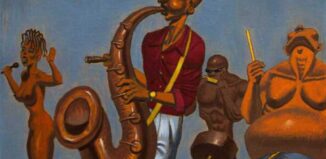THE GREAT EMPTYING OF THE THREE TRIANGLES
by Marianne Villaneuva
A presentation by Brian Siy
The present condition of the area known as the Three Triangles, is desert. The desertification occurred around 1511. Several decades later, the first instances of human migration to the coast began.
Our first clue to what may have occurred came with the discovery of the Aurora Trench. By monitoring its striations closely, I have been able to ascertain that the area had, for a period of over 500 years, suffered from intense precipitation, unusual wind strength, and heat. This was undoubtedly the reason behind the Great Vanishing.
In the space of little more than 100 years, 323 cities, most of which had flourished on the alluvial plain for millennia, disappeared. It was clear from detailed analysis of total organic carbon (TOC) that the degree of vegetation cover began to oscillate in a manner inconsistent with normal summer monsoon patterns.
The climate grew appreciably colder and dryer. There is scientific confirmation in the archaeological evidence of the trench, which henceforward was given the name Maowusu, which in the ancient language meant: the Supreme Utilization.
Now let us turn to the thirty-four cities whose archaeological evidence is most verifiable. These were clustered at the edges of the plain. Astonishing detail was provided by the populace’s habit of record-keeping. Everything, from the weather to the types of vegetation and the specific locales in which they flourished, were recorded on clay tablets, which collectively were known as The Annals. The Annals recorded the yearly arrival of the sparrows, and the dates on which the river (the Mother River was named Zhu, or “Discord”; the secondary river Araw or “Day”) began to freeze, were set down.
The first onset of the strange weather was recorded, as were the years of terrible drought which followed.
It was also recorded that the river Zhu, previously muddy and brown, turned clar. While the river Araw, whose waters were clear and sparkling, grew sluggish and heavy with silt and other decayed matter.
There had apparently once been a network of waterways and canals that the populace used to move food and other necessities to one another’s villages and towns. There was evidence of exchange of goods (what we today refer to as barter).
Whole communities were cut off from one another. The estuaries silted up.
Inevitably, the population declined. One can cite the usual reasons: starvation, epidemics, and migration. Trouble and disturbances were widespread. Slavery became commonplace. Not only that, there was a plague of locusts. Cannibalism became a way of life.
It is of no surprise then, to note the appearance of The Diviner’s Handbook, whose publication dates from a period roughly between 1622 and 1681. This handbook was the work of one man, who signed his name Jo-yu. The handbook begins with this sentence: “There was a great drought.” The handbook is little more than a compilation of exotic rituals, rituals which, for the inhabitants of the region, seemed to contain a form of transcendent significance. Rituals to accompany the rising and setting of the sun, of the stringing of bows (archery contests were a frequent occurrence, right to the very end of this civilization), births, funerals, weddings, and sacrificial offerings.
The strangest artifacts from this period were the drawings of two-headed creatures left on cave walls. It is not certain whether these were mythical or actual beings. Certainly, the occurrence of conjoined twins is a sad anomaly, but in the period of the Great Drought, it seemed there was a proliferation of such births.
Beneath one such drawing of conjoined heads were the words: “Our mother has abandoned us.” Since the word “Mother” at the time had a multiplicity of meanings, one could infer that it referred to the fecundity or lack of fecundity of the soil; to the river water, which had for so many centuries sustained commerce and life; or perhaps to an actual person, a woman, who had run shrieking with horror at the blight produced by her womb. All is left for scholars to conjecture.
Gradually, the people of one village lost the ability to communicate with those of another village, even though the two might have been less than two kilometers apart. Each village began to establish its own customs.
The people, therefore, had good reason to abandon their ancestral graves. Mother, father, grandparents and children were buried at a point just south of the Altai River. The populace was already very weak, the rulers unable to staunch the flow of new people, barbarians wearing bear skins, from the far north.
The Sadness
The first group left for the northwest in March. They settled at a branch of the Ma-I River and arranged their homes in a defensive position.
The earlier settlements were strung out along Ma-I like beads on a string.
On of the earliest group of refugees to settle by the river was led by a most devout monk named Dao-an. Fifty-eight years old at the time of the migration, he is described in a fragmentary work of questionable reality as having a beard as white as snow, and back bent almost double from some childhood trauma, perhaps a fall. He was carried everywhere by four men in a palanquin.
In the next few decades, these settlements began to conduct minor skirmishes against each other. Most of these skirmishes were conducted over the attempt to control the waterway. Other villagers attempted to band together and to dig new canals. One of these was quite long, almost 400 li. But, ultimately, this attempt failed. The villages on the opposite bank sent fire arrows which burned the supply boats and the men were forced to swim for the shore, where they were cut down by hails of arrows.
In addition, these river settlements were continually harassed by a brand of marauding, dark people who came down from the hills. They had lived in that area probably for centuries. Perhaps they were off-spring of the men from the south, but having lived so long in the hills they had evolved a completely different language. Their main purpose was to acquire young woman to bear their children.
There was also the need for the construction of wells.
The next campaigns were the Campaign for the Freeing of the Mountain Routes, and another the Campaign for the Crossing of the Treacherous Cliffs.
Conclusion
In effect, what the trench tells us is that the plain of the Three Triangles experienced devastating drought and freezing weather patterns, which caused the complete disintegration of human civilization. Whole settlements of people vanished, and it is not yet clear whether the emptying of the plain was due to emigration, internecine strife, or epidemics and starvation.
I cannot tell you how much it has meant to me, dear ladies and gentlemen, that you have remained seated there, so quietly, in spite of the abysmal state of the airconditioning in this august building and my shortcomings at Power Point. I am perhaps a Luddite: technology is a barrier to truth. This is no doubt amusing to those of you in the audience who cannot remember an age before Apple. But I assure you, I assure you, that I am most humbly cognizant of your discomfort, and trust that my words have provided you with at least some measure of entertainment and distraction, no matter how brief.
BIO
Marianne Villanueva was a finalist for the UK’s Saboteur Award, in 2014. And a full-act opera based on her novella, Marife, received its world premiere in New Hampshire in 2015. She is currently teaching a class called, One Story: Six Ways for UCLA Extension’s Writers Program, Aug. 3 (six weeks, online).
.

















